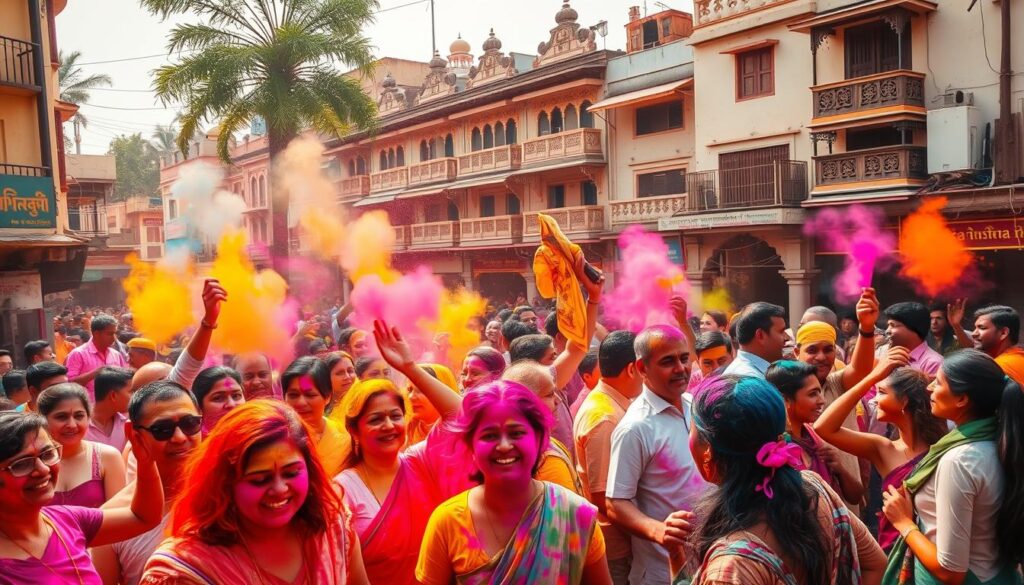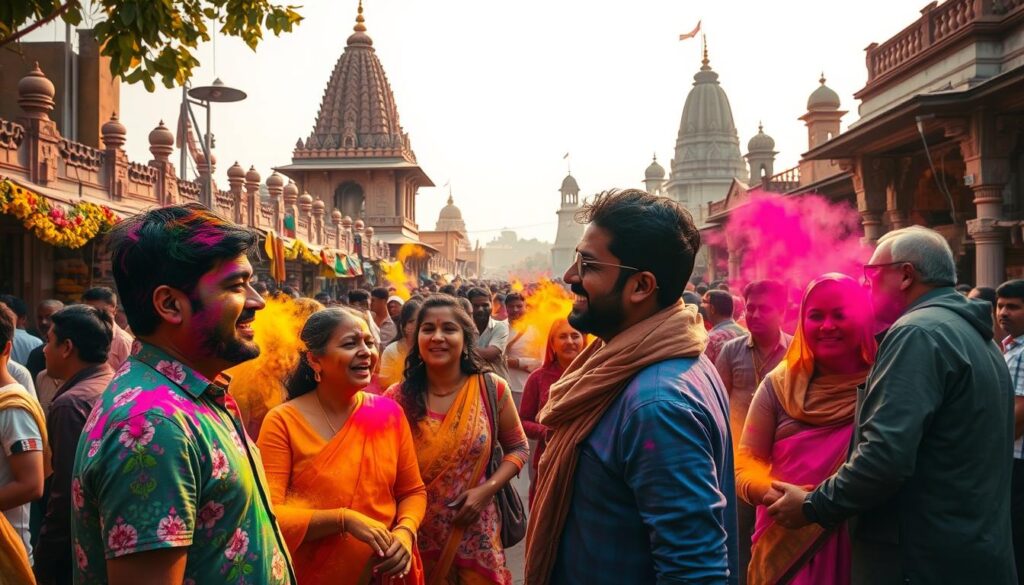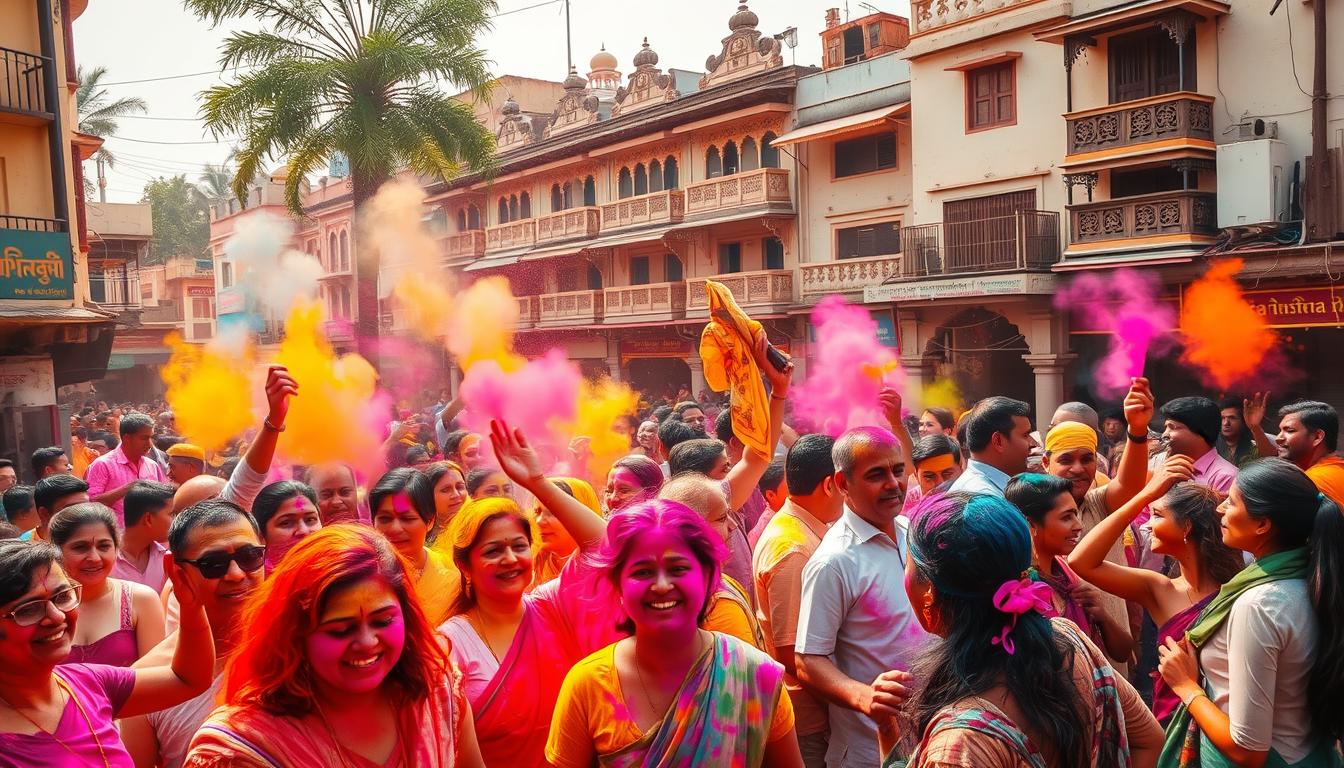Festival of Color Fights in India, The Holi festival, also known as the Festival , is a big deal in Indian culture. It’s celebrated with lots of excitement all over the country. It welcomes spring and celebrates good winning over evil.
Holi is a key part of Indian festivals, showing off the country’s rich culture and lively traditions. It’s a time for people to unite, put aside their differences, and enjoy the fun of Holi.

Holi is one of the most loved Indian festivals. It’s all about joy, love, and being together. It’s a special chance to dive into India’s colorful culture. This article will help you learn about Holi and experience it for yourself.
Introduction to Festival of Color Fights in India
Holi is a time for new beginnings, a chance to let go of the old and welcome the new. It celebrates good winning over evil and the start of spring. Holi is a big part of India’s cultural heritage, and it’s a major event in the Indian calendar.
Key Takeaways Festival of Color Fights in India
- Holi is a significant event in Indian culture, celebrated with great enthusiasm across the country.
- The festival marks the beginning of spring and the triumph of good over evil.
- Holi celebrations are an integral part of Indian festivals, showcasing the country’s rich heritage and vibrant traditions.
- The Festival of Color Fights in India is a time for people to come together, forget their differences, and indulge in the joy of Holi celebrations.
- Indian festivals like Holi are an integral part of the country’s cultural heritage.
- The festival is a celebration of the triumph of good over evil, and the arrival of spring.
The Ancient Origins of Holi Festival
The Holi festival has a rich Holi history that goes back to ancient Hindu mythology. It celebrates the victory of good over evil. People come together, forget their differences, and enjoy color fights that symbolize joy, love, and spring’s vibrant colors, Festival of Color Fights in India
The festival centers around the legend of Prahlad and Holika, showing the eternal battle between good and evil. This story has been passed down for generations. It highlights the festival’s cultural and spiritual value.
The color fights are a newer part of Holi. They let people express themselves and have fun. The colors used represent spring’s vibrant hues and are a key part of the Holi history. As the festival grows, its Hindu traditions stay at its core.
Some key parts of the Holi festival include:
- The burning of Holika effigies, showing good’s victory over evil
- The use of colors, symbolizing joy, love, and spring’s colors
- People from all walks of life coming together, creating a sense of community and unity
When and Where to Experience Holi in India
India is famous for its lively Indian festivals, and Holi celebrations are a big hit. The Festival of Color Fights in India is a major event in the country. It’s important to know when and where to see it. Holi usually happens in late February or early March, based on the lunar calendar, Festival of Color Fights in India
For the best experience, visit cities like Mathura, Vrindavan, and Jaipur. These places are known for their Holi celebrations. They offer unique and unforgettable experiences, making them a must-see during the Festival of Color Fights in India. Some fun activities to enjoy during Holi include:
- Participating in color fights and throwing colored powders
- Watching traditional dances and musical performances
- Tasting local delicacies and drinks
India is the perfect spot to experience the Festival of Color Fights in India. Whether you’re into Indian festivals or seeking a unique adventure, Holi is an event you won’t want to miss. So, start planning your trip and get ready to dive into the colorful world of Holi celebrations.
Traditional Festival of Color Fights in India: What to Expect
The Festival of Color Fights in India is a big part of Holi in India. People throw colored powders and waters at each other. This shows the joy and vibrancy of the festival.
This tradition is a key part of Holi customs, which have lasted for centuries.
Over time, the colors used have changed. Now, you can choose from natural and synthetic colors. The choice depends on the region and personal taste, making the celebrations diverse and rich.
Types of Colors Used Festival of Color Fights in India
- Natural colors, such as those derived from flowers and herbs
- Synthetic colors, which offer a wider range of hues and shades
Traditional Customs and Rituals
The Holi customs and rituals, like Holika Dahan, happen before the colorful day. These customs and rituals are key to the traditional celebrations. They bring people together and strengthen community bonds, Festival of Color Fights in India
Musical Elements and Dance
Music and dance are big parts of the festivities. Traditional songs and dances fill the air. The lively atmosphere is filled with drumbeats and trumpet sounds, adding to the excitement and joy.
Regional Variations of Holi Celebrations
Indian festivals like Holi show the country’s rich culture. The regional Holi celebrations highlight India’s diversity. Each state and region has its own special customs and traditions.
In West Bengal, Holi is called “Dol Jatra” or “Basanta Utsav.” It’s celebrated with a colorful procession and throwing of colors.
The cultural variations of Holi make it special. Different places celebrate Holi in their own way. This makes it exciting for visitors to see.
- Dol Jatra in West Bengal, which involves a procession and the throwing of colors
- Basanta Utsav in Odisha, which is a celebration of the arrival of spring
- Holika Dahan in Gujarat, which involves the burning of effigies to symbolize the victory of good over evil
These regional Holi celebrations are key to the festival. They make Indian festivals richer and more diverse. By experiencing these customs, visitors can understand Holi’s cultural importance.

Essential Preparations for Participating in Holi
To enjoy Holi fully, you need to prepare well. This means taking Holi safety steps, getting ready for the festival, and protecting your skin, hair, and things. This way, you can have fun without worries.
Preparation Checklist
Here’s a checklist to help you get ready for Holi:
- Wear old or disposable clothes to avoid stains on your favorites
- Apply moisturizers and oils to protect your skin from colors
- Cover your hair to prevent color damage
- Use a waterproof camera or phone case to protect your devices
- Keep your valuables safe and secure
Additional Tips Festival of Color Fights in India
Also, remember to drink water and take breaks to avoid getting too tired. By following these protective measures and getting ready for the festival, you’ll have a great and safe Holi experience.
Traditional Holi Foods and Beverages
The Holi festival is a time to enjoy many traditional foods and drinks. These are key parts of the celebrations. The festival cuisine includes sweet and savory dishes that make the festival more fun. You can try gujiya, a sweet dumpling, or papri chaat, a spicy snack.
Popular traditional drinks include thandai, a cold drink with milk, sugar, and spices. These drinks are refreshing and offer a special taste experience. Here are some popular Holi foods and drinks:
- Gujiya: a sweet dumpling filled with dried fruits and nuts
- Papri chaat: a spicy snack made from boiled potatoes and chickpeas
- Thandai: a cold drink made with milk, sugar, and spices
These traditional Holi foods and drinks are loved by all ages. They make the festival even more special.

Safety Tips for Foreign Visitors
Participating in Holi as a foreign visitor can be exciting. But, it’s key to follow festival precautions for a safe and fun time. Knowing local customs and respecting the festival’s culture is important.
To stay safe, follow Holi safety tips like staying in groups and being aware of your surroundings. Also, protect yourself from colors and crowds. Here are some tips:
- Stay hydrated and bring sunscreen to protect yourself from the sun
- Wear old or disposable clothing to avoid damaging your favorite clothes
- Bring a change of clothes and a towel to clean up after the festivities
- Avoid carrying valuable items or large amounts of cash
By following these Holi safety tips and taking festival precautions, you can have a great time celebrating Holi in India. Remember to respect the local environment and traditions.
With the right mindset and precautions, you can dive into Holi’s vibrant colors and joy. You’ll make unforgettable memories in India.
Environmental Impact and Eco-Friendly Celebrations
The Holi festival celebrates life and nature but has a big environmental impact. This is because of synthetic colors and how we dispose of waste. Many are now choosing eco-friendly Holi, using natural colors and sustainable ways.
To make Holi greener, we can use biodegradable stuff, cut down on waste, and support eco-friendly products. This helps protect our planet and keeps the festival joyful and nature-focused.
Natural Color Alternatives
Using flowers, herbs, and natural dyes for Holi is a smart move. These options are good for the earth and safe for us. They make Holi safer and more eco-friendly.
Sustainable Celebration Practices
Practicing sustainable Holi, like using biodegradable items and reducing waste, is key. We can use reusable cups and plates, compost food, and recycle paper and plastic. These steps help lessen Holi’s environmental effect.
By choosing eco-friendly Holi and supporting sustainable celebrations, we can keep the festival green. This way, Holi will continue to celebrate life and nature for many years.
Modern Interpretations of Holi
The Holi festival has changed a lot over the years. It now mixes old traditions with new ideas. This mix keeps the festival exciting for young people, making it a lively part of Indian culture.
Today’s modern Holi includes modern music, dance, and art. These additions have brought in new fans and refreshed old traditions. Holi now is a place where people share and learn about Indian culture in fresh ways.
Some key parts of contemporary celebrations are:
- Modern music and dance performances
- Art exhibitions and installations
- Cultural workshops and seminars
- Food festivals and culinary events
These changes have made Holi known worldwide. They also give artists and musicians a chance to shine. The modern Holi shows India’s deep culture and its ability to grow and change.
Cultural Etiquette and Respectful Participation
Understanding the cultural etiquette and social customs of Holi is crucial. Respectful participation makes sure everyone has a good time. It’s important to respect people’s wishes and not push them to join in.
This respect is a key part of Holi customs. It helps make the celebration welcoming and positive for everyone.
To enjoy Holi with care, knowing the do’s and don’ts is helpful. For example, it’s key to respect those who don’t want to join in. Following these rules helps build a sense of community and respect.
- Respecting people’s personal space and boundaries.
- Avoiding the use of harmful or toxic colors.
- Being considerate of the environment and avoiding litter.
By following these principles ofcultural etiquetteandrespectful participation, we can make Holi better for everyone. This makes the festival more enjoyable and helps us appreciate theHoli customsand traditions more.
Conclusion: Festival of Color Fights in India
As the Holi festival ends, we remember the colors and laughter. These remind us of the cultural celebration that brings us together. This Festival of Color Fights in India is more than fun. It’s a deep celebration of life, love, and victory over evil.
Holi teaches us about its traditions and history. It’s not just about fun and colors. It’s about coming together, making friends, and enjoying pure joy.
As we say goodbye to Holi for another year, let’s hold onto the memories. Let’s remember the laughter, togetherness, and energy. The Holi spirit reminds us of unity, diversity, and humanity’s strength.
FAQ
What is the significance of the Holi festival in Indian culture?
Holi, or the “Festival of Color Fights in India,” marks the start of spring and good winning over evil. It’s deeply rooted in Hindu myths. Over time, it has grown to include many customs and traditions celebrating joy, love, and vibrant colors.
When and where can I experience the Holi festival in India?
Holi happens in late February or early March, based on the lunar calendar. Famous celebrations are in Mathura, Vrindavan, and Jaipur. These places offer unforgettable experiences for visitors.
What should I expect during the traditional Festival of Color Fights in India fights in India?
The color fights are a key part of Holi. People throw colored powders and waters, showing the festival’s joy and vibrancy. Music, dance, and Holika Dahan are also big parts of the festivities.
Are there any regional variations in how Holi is celebrated across India?
Yes, Holi is celebrated differently across India. States have their own customs, traditions, and names for the festival. This adds to the festival’s richness and diversity.
What should I consider when preparing to participate in Holi celebrations?
To enjoy Holi, prepare by wearing old clothes and protecting your skin and hair. Also, keep your camera and valuables safe. This way, you can fully enjoy the festivities without worries.
What are some of the traditional Holi foods and beverages I can expect to find?
Holi is a time for traditional foods and drinks. You’ll find sweet treats like gujiya, savory dishes like papri chaat, and drinks like thandai. These add to the festive atmosphere and offer a unique taste experience.
What safety tips should foreign visitors keep in mind when participating in Holi?
For foreign visitors, Holi can be exciting but requires safety precautions. Understand local customs, respect the festival’s cultural significance, and protect yourself from colors and crowds. Being aware of your surroundings and following local advice ensures a safe experience.
How can Holi celebrations be made more eco-friendly?
There’s a growing effort to make Holi more eco-friendly. Many use natural colors and adopt sustainable practices. This helps reduce the festival’s environmental impact.
How have modern interpretations of Holi evolved over time?
Holi has evolved, adding modern elements like music and dance. This keeps the festival appealing to younger generations, ensuring its continued vibrancy.
What cultural etiquette and social customs should be observed when participating in Holi?
When participating in Holi, it’s important to know the cultural etiquette. Respect people’s boundaries and avoid forcing them to join color fights. This ensures the celebration is enjoyable and respectful for all.
Source link
- https://www.thetimes.co.uk/article/holi-celebrations-in-india-where-to-go-and-what-to-do-k6jp3h98d
- https://kids.nationalgeographic.com/pages/article/holi
- https://es.wikipedia.org/wiki/Holi
- https://www.pbs.org/newshour/world/millions-celebrate-holi-the-hindu-festival-of-colors
- https://apnews.com/article/91afef090855e56b9edb89b66b72e9b0
